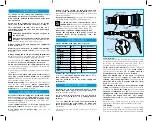
For advice on the safety and suitability of this
equipment contact your local HSS Hire Shop.
Keep children, animals and bystanders away from
the work area.
Never use this equipment if you are ill, feeling
tired, or under the influence of alcohol or drugs.
This equipment should only be used by a
competent person who has read and understood
these instructions.
Safety Goggles MUST be worn by everyone in
the work area.
Wear practical, protective clothing, gloves and
footwear.
Avoid loose garments and jewellery that
could catch in moving parts, tie back long hair.
Always switch OFF and unplug the equipment
when not in use.
Make sure you know how to switch this machine
OFF before you switch it ON,
in case you get into
difficulty.
Always unplug the tool before making adjustments
to it.
Check that it is switched OFF and that you have
removed the chuck key before plugging it back in.
Having switched OFF,
always wait for the drive head
to come to rest before putting the tool down.
Check the condition of the equipment before use.
If it shows signs of damage or excessive wear, return it to
your local HSS Hire Shop.
Only change the direction of rotation when the machine
is stopped.
Take special care when fixing into walls or floors,
they may contain hidden pipework or electrical
cables.
If in doubt, hire a metal locator, to determine the
exact position of such hazards.
Watch your footing.
Take special care if working other
than on firm, level ground.
Above ground-level,
always work from a stable, purpose-made work
platform
such as a step-up or trestle.
Most HSS screwdrivers plug into a standard 13amp
power socket.
However,
110V models
(with a round
yellow plug)
must be provided with a suitable 110V
generated supply,
or powered from the mains via a
suitable 110V transformer.
If the equipment fails, or if its flex or plug gets
damaged, return it.
Never try to repair it yourself.
Keep flexes out of harm’s way,
and clear of
moving parts.
ELECTRICAL SAFETY
GENERAL SAFETY
Extension leads should be fully unwound and
loosely coiled, away from the equipment.
Never run
them through water, over sharp edges or where they
could trip someone.
Keep the equipment dry,
using electrical equipment in
very damp or wet conditions can be dangerous.
To reduce the risk of electric shock, use a
suitable RCD
(Residual Current-Operated Device)
available from your local HSS Hire Shop, or power the
equipment from a mains circuit with a built-in RCD.
Never carry or pull the equipment by its flex.
Ensure the equipment and power socket are
switched OFF before plugging into the
power supply.
Fit the machine with right bit for the job.
Remove the outer sleeve
to reveal the 1/4” hexagon
drive socket.
Insert the required drive bit
(see chart),
then replace the outer sleeve.
Plug the machine in to its power supply and
switch ON.
Hold the tool in both hands and adopt a stable
stance that gives a good view of the work
while
keeping you clear of the bit.
Do not work in areas where you are forced to
stand on loose debris or on a slippery uneven
surface.
If possible,
drape the tool’s flex over one shoulder to
keep it clear of the screw/fixing,
but
make sure
there is still enough slack
so you are not restricted in
movement.
Practice on an area of the work which will not
be noticed.
BASIC TECHNIQUES
GETTING STARTED
Screw-driving...
All models work on the principle that, when the screw
has been driven into the material to the required depth,
the driving tip disengages from the screw. This is
achieved by adjusting the depth gauge setting.
Fit the screw to the drive bit
(the socket is magnetic
and should hold the screw with ease).
Set the torque
adjustment collar
to No. 18. Confirm that the
Forward Reverse selector is set to forward.
Offer the machine up to the work,
then
gently
squeeze the
ON/OFF
trigger to start the bit
rotating, place enough pressure
on the machine
to
allow the bit to stay in contact with the screw
head
as it enters the work.
The machine will drive the screw until the depth
setting is reached,
whereupon the bit will cease to
travel forward.
Check the setting
of the screw and
if
the head is imbedded too far
into the work
or is
sitting proud of the work, adjust the depth setting.
To adjust the depth turn the
depth
gauge
clockwise to decrease
the setting
and anti-clockwise
to increase.
Once set, you should not have to make any more
adjustments, other then when the bit becomes worn.
TEK Driving...
This system of driving a hexagonal headed fixing,
requires the driving bit to stay in contact with the fixing
at all times. Therefore, you must first adjust the depth
Screw Head
Bit
Screw Diameter
TEK
8mm
All Sizes
Pozidrive
No 1
2.5 – 3.0mm
Pozidrive
No 2
3.5 – 5.0mm
Pozidrive
No 3
5.5 – 7.0mm
Philips
No 1
2.5 – 3.0mm
Philips
No 2
3.5 – 5.0mm
Philips
No 3
5.5 – 7.0mm
Slot
4.0mm
3.0mm
Slot
5.5mm
3.5mm
Slot
6.5mm
5.0mm
Forward/Reverse
Selector
ON / OFF
Trigger
Torque
Collar
Depth Setting
Adjuster




















